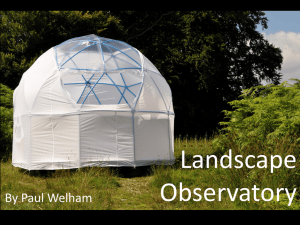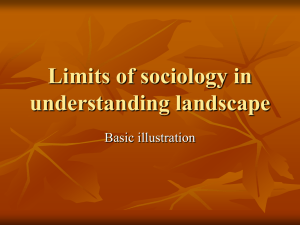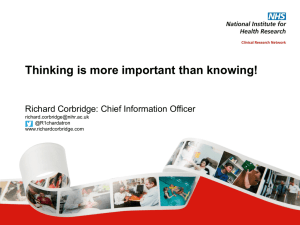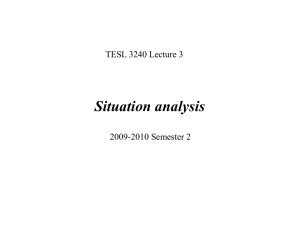Read more
advertisement
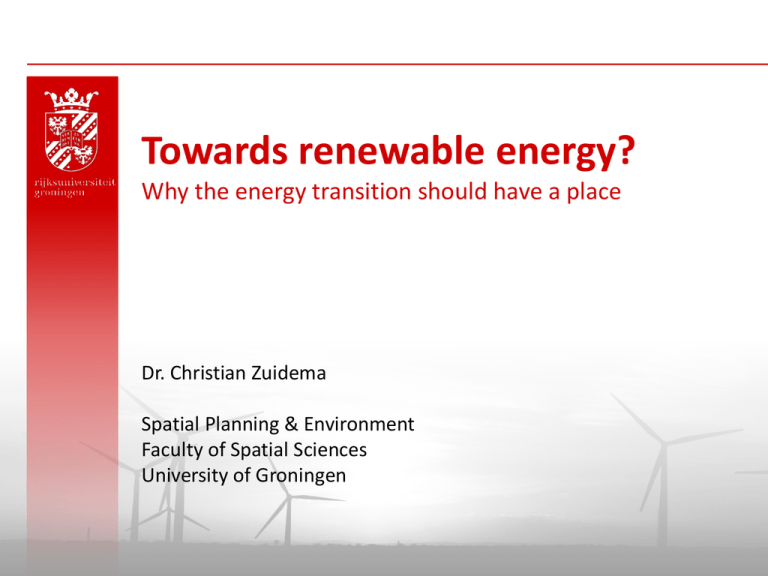
Towards renewable energy? Why the energy transition should have a place Dr. Christian Zuidema Spatial Planning & Environment Faculty of Spatial Sciences University of Groningen Today 1| Issue 2| Energietransition 3| Area-based innovation 4| Questions & Discussion 1| Issue Wat we al weten We zijn zwaar verslaafd aan fossiele energie Three core issues 1| Fossil fuels are not renewable and limited We will eventually run out of them, and then what? Three core issues 2| Climate change is an increasingly big issue to which the burning of fossil fuels is a big contributor We should rather use other resources Three core issues 3| Geopolitical relations matter in interdependency On whom do ‘we’ want to depend Problem … › Obama; Oval Office Speech 15-06-2010; “For decades, we have known the days of cheap and easily accessible oil were numbered. For decades, we’ve talked and talked about the need to end America’s century-long addiction to fossil fuels. And for decades, we have failed to act with the sense of urgency that this challenge requires… But it is difficult… › After all: 1| We have high needs for energy 2| There are huge economic interests 3| There are important and vested interests in power 4| There are existing investments 5| We are largely unaware 6| We do not pay the real costs 1| We need lots of energy We have high and rising needs for energy - Food Construction User products Transport Comfort Netherlands per person: - 208 GJ per year - That is 5.000 liter oil - Or 5.400 m3 gas But it is difficult Fortune 2012 – biggest companies in the world 1 Royal Dutch Shell the Netherlands Petroleum 2 ExxonMobil United States Petroleum 3 Walmart United States Retail 4 BP United Kingdom Petroleum 5 Sinopec China Petroleum 6 China National Petroleum Corporation China Petroleum 7 State Grid Corporation of China China Power 8 Chevron United States Petroleum 9 ConocoPhillips United States Petroleum Japan Automobile 10 Toyota But it is difficult Richest countries in the world (2013 Worldbank) 3| Vested stakes (power) Example: Dutch government - Eneco Nuon (about 25%) Delta (Zeeland) Gasterra: State (50%), Exxon (25%), Shell (25%) 4| Existing investments 4| Existing investments 5| We are largely unaware 5| We are largely unaware 22 kilograms 61 kilograms 0,2 kilograms 6| We do not pay the real costs - Pollution Health and human lives Taxes and subsidies Climate “The benefits of strong, early action on climate change outweigh the costs.” -Climate change will affect world GDP to 5-20% a year -We need about 1% of the global GDP to avoid the worst The real challenge Sense of Urgency Willingess to Change Willingness to Act Efforts Ability to Act Ability to Change Sense of Control The real challenge › “Problems are a complex web of interrelated actors and networks, both in a physical, economic, social and institutional sense.” › “Apart from limitations to fully oversee and grasp such a complex web, ownership and power are fragmented, limiting the capacity of any actor to alter them” (De Boer & Zuidema 2013) 2| Transitions Path-dependent / Lock-in Dynamic equilibrium A system that has found a state in which it stays relatively stable (between certain borders). If it is also resistance to change: path-dependency & lock-in Transitions The idea of a socio-technical or societal ‘transition’: A fundamental transformation from one dynamic equilibrium to another - Industrial revolution Demografic transition Electricity ICT … Transitions Involves processes of self-organisation and co-evolution, involving the linking of processes of change in various societal, economic, and technological domains This system largely changes by itself = Idea of planning by exerting control Transition ‘management’ Socio-technical landscape: common practices, culture, values, opinions, beliefs, assumptions, etc. - changes slowly Regimes: the existing systems of regulations, laws, infrastructure, power, contracts, organisations, etc. – tends to resist change Niches: the place where innovations take place in relative isolation – typically on a local/individual scale – so bottom-up developments – more rapid changes Transition ‘management’ • • • • Stimulate innovation in ‘niches’ Learning-by-doing Allow for multiple developments (not rigid) Make regimes more flexible so they can change Hope: slowly changing societal and cultural conceptions and successful niche activities (innovations/lessons) can alter the regime Transitions But this remains fairly abstract… what can we do in practice? -Change societies and economies? -Change institutions? -Change the technology and physical landscapes? -What about (spatial) planning then? An example: The Netherlands … CBS (2012) An example: The Netherlands % hernieuwbaar … An example: The Netherlands 2011: 4,3% 2012: 4,5% 2013: 4,5% An example: The Netherlands 2011: 4,3% 2012: 4,5% 2013: 4,5% Why is it so hard? 75% Space forces us asking questions • • • • Can NL be 100% sustainable? Should we import sus-energy? Should we focus on other experitise? NIMBY (not in my back yard) So… Transitions? Rotmans (2011): More than top-down by central government; not just a focus on technology! Hajer (2012): Use social innovation and entrepreneurship – people are a key issue Understand the local 3| Area-based innovation Think spatially • Energysystems are not isolated from our society and physical landscape • Innovations (in niches) also do not occur in isolation • Any sense of co-evolution requires the interaction between various physical or social systems – so also between the energy system and its context Framing the energy system as embedded in the physical and socio-economic landscape -> Integrated energy landscape 1 Understanding the challenge Current (recent…) fossil fuel based energy system: - The energy system is physically and institutionally largely seperated from other spatial and societal functions - Limited visibility (underground & far away) Energy is ‘footloose’ = Space is implicit Economic affairs dominates arena Limited societal actor involvement 1 Understanding the challenge System based on renewables will be different : - Visible (above the ground and more space needed) Closer to people (in and around houses or towns) Towards the ‘prosumer’ Energy security – behaviour or space? Involves many societal actors and subsectors 2 Responding to the challenge The area-based niche: - Intergation with the local physical/spatial landscape is crucial (potentials, limits, scources, embedding, transport, storage) - Integration with the local socio-economic landscape is crucial (support, synergies, investments, producersconsumers) 2 Responding to the challenge Thinking spatially and seeing energy as a visible element in the landscape Connections between functions, land uses, actors, interests are all literally becoming visible Local qualities and identities can be connected Integrated energy landscape: Helps for understanding where to do what? Integrated energy landscape: Helps for understanding where to do what? Oven Pool School Voetbal Elderlyhome School Houses Integrated energy landscape: Helps to see how the energy-system might be integrated in the physical-spatial and socio-economic landscape | Regional development Integrated energy landscape: Helps to see how the energy-system might be integrated in the physical-spatial and socio- economic landscape | Identity & Participation With the development of institutional & social capital - Networks - Partnerships - Local sustainable energy companies - Institutional barriers become visible Integrated energy landscape: Provides direction to policies - Not monofunctional ‘energy’ but an integrated vision Not one sub-sector, but a broad societal endeavor Relation local context crucial Top-down and bottom-up Conclusions • The framing of a ‘niche’ within ‘transition thinking’ should include ‘area-based’ innovations and practices • Thinking spatially helps us identify linkages between societal subsystems, both in terms of barriers (allocation) and opportunities (synergie) • Thinking spatially helps us understand the problem of shifting to a sustainable energy system and provides direction towards a response 4| Questions & Discussion

